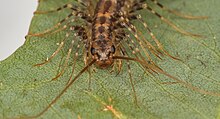| Scutigeromorpha | |
|---|---|

| |
| Close-up of a common scutigeromorph | |
| Scientific classification | |
| Domain: | Eukaryota |
| Kingdom: | Animalia |
| Phylum: | Arthropoda |
| Subphylum: | Myriapoda |
| Class: | Chilopoda |
| (unranked): | Pleurostigmomorpha |
| Order: | Scutigeromorpha |
| Families | |
Scutigeromorpha, also known as house centipedes,[1] are an order of centipedes. They are anamorphic,[2] and can reach 15 leg-bearing segments in length. They are very fast creatures, and able to withstand falling at great speed: they reach up to 15 body lengths per second when dropped, surviving the fall. They are the only centipede group to retain their original compound eyes, within which a crystalline layer analogous to that seen in chelicerates and insects can be observed. Another distinctive feature is their long and multi-segmented antennae.[3] Adaptation to a burrowing lifestyle has led to the degeneration of compound eyes in other orders; this feature is of great use in phylogenetic analysis. The group is the sole extant representative of the Notostigmomorpha, defined by having a single spiracle opening at the posterior of each dorsal plate. The more derived groups bear a plurality of spiracular openings on their sides, and are termed the Pleurostigmomorpha.[4] Some even have several unpaired spiracles that can be found along the mid-dorsal line and closer to their posterior section of tergites. There are three families: Pselliodidae, Scutigeridae and Scutigerinidae. Pselliodidae includes just a few species in the genus Sphendononema (=Pselliodes), occurring in the Neotropics and tropical Africa. Scutigerinidae, composed of three species in the genus Scutigerina, is restricted to southern Africa and Madagascar. Most scutigeromorphs from other parts of the world belong to the Scutigeridae, which includes two subfamilies, the Scutigerinae and Thereuoneminae. There are a total of about 96 species and subspecies of Scutigeromorph centipedes.[5]
The earliest known fossil centipedes belong to the order Scutigeromorpha; they have been identified as such due to the morphology of the legs and the maxillipeds.[6]